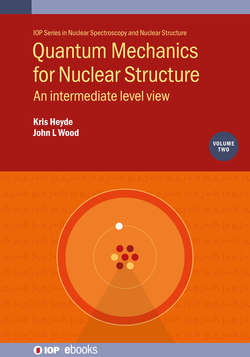Читать книгу Quantum Mechanics for Nuclear Structure, Volume 2 - Professor Kris Heyde - Страница 26
На сайте Литреса книга снята с продажи.
1.17.1 Representation of operators
ОглавлениеConsider the operator O and its representation, O↔Γ(O) in terms of z and ∂∂z, O(z,∂∂z) acting on z-space wave functions, Ψ(z). This is similar to the procedure presented in Volume 1, chapter 8, where, e.g. the operator px (momentum in the x direction) was shown to have a ‘position’ representation px↔−iℏ∂∂x when acting on Cartesian-space wave functions Ψ(x,y,z). The key there is to define a position eigenket basis {∣x〉} and arrive at statements such as 〈x∣pˆx∣Ψ〉=−iℏ∂∂x〈x∣Ψ〉=−iℏ∂Ψ(x)∂x. Thus, we proceed with the ∣z〉II basis, (∣z〉II≔ez*a†∣0〉, cf. Volume 1, section 5.5, equation (5.118))
O∣Ψ〉⇒ΓOz,∂∂zΨ(z)=II〈z∣O∣Ψ〉=〈0∣ezaO∣Ψ〉=〈0∣(ezaOe−za)eza∣Ψ〉=〈0∣O+[za,O]+12[za,[za,O]]+⋯eza∣Ψ〉,(1.282)
where the Baker–Campbell–Hausdorff lemma is used (cf. Volume 1, chapter 5, equation (5.110)). Essentially all operators of relevance can be expressed in terms of a and a†, whence: for O=a
and from ∂∂z(eza)=aeza
⇒Γ(a)=∂∂z.(1.284)
For O=a†
Note:
1.∂∂z,z=1,cf.[a,a†]=1.(1.286)
2. z and ∂∂z are Hermitian adjoints for scalar products defined on Bargmann measure:e.g.forΨa=∑nanzn,Ψb=∑nbnzn,(1.287)∫∫dze−∣z∣2πΨa*∂∂zΨb=∑nan*bn+1(n+1)!=∫∫dze−∣z∣2πΨb(zΨa)*.(1.288)
